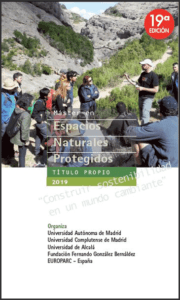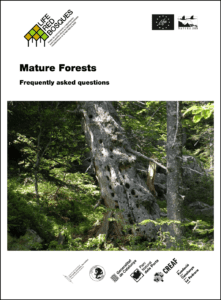MSc in PROTECTED AREAS 2019 – EUROPARC Spain
Once again, EUROPARC Spain and the Fernando González Bernaldez Foundation have launched the XIX edition of the Master en Espacios Naturales Protegidos (Master in Protected Areas) promoted by three prestigious Spanish Universities. Registrations are now open until 31st of October!
A Master degree for future Protected Area managers
The Master in Protected Areas is an advanced postgraduate programme focused on taking students closer to the reality of protected area professional. It is aimed at those who develop or seek to develop their professional activity in the field of nature conservation, both managers and technicians who want to complete their specific training, as well as young graduates interested in working in this field.
It was first released in 2001, it is designed to meet the needs of different academic and professional trajectories and it has been taught succesfully and without interruption since then. Until today, more than 600 participants from around thirty different nationalities have successfully followed it. The programme aims to tackle both the functioning of natural systems and the management techniques and modes of intervention in the socio-economic environment.
The Master in Protected Natural Spaces is jointly organized by three Spanish universities with extensive experience in the environmental field, the Autonomous University of Madrid, the Complutense University and the University of Alcalá, through the Fernando González Bernáldez Foundation and in collaboration with EUROPARC-Spain. It has the support of the BBVA Foundation that supports a scholarship program for Latin American students. The students obtain at the end of the course the own title of Master in Protected Natural Spaces, issued jointly by the three conveners universities.
The Master will be fully imparted in Spanish language, although some knowledge of English language for the literature review is advised. During a one year programme composed by face-to-face and virtual sessions, the students will cover:
• An in-depth reflection on nature conservation and environmental management in the context of sectoral policies and strategies at national and international level;
• A critical analysis of the role of protected areas in the context of Global Change and the relationships between ecosystems and sustainability.
• Planning, management and evaluation tools to positively intervene in the conservation of natural spaces;
• Concrete analysis and intervention tools to support the contribution from protected spaces to human well-being;
Funding opportunities
For those interested in economic support, up to 4 scholarships to cover the tuition fees are available and can be requested at the time of pre-registration. The award will be granted based on the professional and academic qualification and on the personal and economic circumstances of the applicants.
The BBVA FOUNDATION, which has among its priorities the promotion of research and environmental training, also collaborates since 2003 by granting scholarships to university graduates and professionals from Latin America. The call for these scholarships for Latin America was closed in February 2018.
Below you can watch the video of the announcement of the Master in Protected Areas 2019:
For more information, please visit the Master en Espacios Naturales Protegidos website, download the leaflet of the Master 2019.
Registrations are now open! Send your engquiries or register by contacting master@fungobe.org.

The House of Volcanoes – A community based initiative in Romania
Haţeg UNESCO Global Geopark
Located in the southern region of Transylvania, Romania, Haţeg UNESCO Global Geopark was established in 2004. Its designation was done from the necessity to protect and to raise awareness on unique archaeological values that have made this region famous worldwide: the “dwarf dinosaurs of Transylvania”.
The remains of more than ten extinct species of dinosaurs that populated this region of Europe 65 million years ago have been found in fluvial and lake deposits, from eggs to well preserved skeletons of adult individuals. Likewise, the area is famous for its historical and cultural sites that contain ruins of ancient civilizations, churches, fortresses and castles. The Geopark embraces 11 municipalities with 38,500 people living within its boundaries.
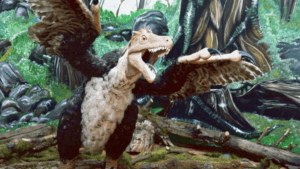
Dwarf dinosaur at Hateg Dinosaurs UNESCO Global Geopark
All the natural, historical and cultural sites of Haţeg are integrated in the management plan of the Geopark, and within the activities promoted we can find education, land planning, nature conservation and research. Furthermore, geo-trails, small museums and several visitors centres have been created together with local communities in an effort to promote its geological heritage and foster the economic development of this rural area.
The House of Volcanoes
The House of Volcanoes brings us an example of one of the most successful projects carried out since the creation of Haţeg UNESCO Global Geopark. This interpretation centre was built with the participation of the local community in order to raise awareness on the geological values that are present in this site. In this short video interview produced in the framework of IMPACT Interreg Europe project, Cristian Ciobanu, Geopark Finances & Heritage Administrator from the University of Bucharest, explains the importance that a project of this kind has for the local community.
For the creation of the House of Volcanoes, the establishment of the NGO “Drag de Hațeg” and the joint forces of volunteers to build the structure were needed. Nowadays, the House of Volcanoes is an important asset for the local community. On one hand, it is a source of economic revenue and a cornerstone for the community in which educational and cultural activities are carried out. On the other hand, this project has allowed youngsters to travel and share their experience with other Geoparks around the world, opening new opportunities for this rural region of Romania.

Frequently Asked Questions about Mature Forests – LIFE Red Bosques
Mature Forest - Photo by Carles Batlles/Lluís Comas
LIFE Red Bosques, the project that aims to improve the management of Spanish Mediterranean forests included in Natura 2000 network, has recently released the key document “Mature Forests – Frequently Asked Questions“. Click in the image below to download the English version of this document (Spanish version also available here)
The work of LIFE Red Bosques is focused on providing the necessary support to a wide variety of professional profiles involved in the management of mature forests included in the Natura 2000 network, including forest managers, protected area managers and technicians from environmental departments of public administrations, land owners, politicians and decision makers. The variety of profiles and knowledgement dictates the necessity to create comprehensive information that responds to the needs of each group and that also provides basic information to non-especialized audiences.
“Did you know that mature forests host greater diverstiy of species and structures than younger forests, making them more resilient to Climate Change?”
Contributing to the appreciation of the forests
“Mature Forests – Frequently Asked Questions” compiles the most commonly asked questions regarding forest maturity by both professionals on this area and the general public. For its creation, LIFE Red Bosques has relied on scientific literature and a large group of experienced experts in the matter with the intention to contribute to the appreciation of the last remainings of the Primeval Forest that still exist in our continent.
The document is divided in 6 sections that cover different subjects, from the explanation of main concepts to the role of mature forests inside the Natura 2000 network. Below you can see the list of topics covered and some of the queries that the document aims to answer:
• On the concept of mature forest – What does mature forest mean? what are the differences between a virgin forest, a mature forest and an old-growth forest?
• On intervention in mature forest – Learn more about the management in mature forests. Are interventions negative? Can we accelerate the state of maturity?
• On harvesting in mature forest – Is forestry possible in mature forests? Is public use of a mature forest compatible with the conservation of its fragile biodiversity?
• On the value of mature stands – Considerations about the economic and social benefits that mature forest bring to society and their role towards climate change.
• On forest disturbances (fires and pests) – Is it possible to have a mature forest in a high-fire-risk environment? Does the presence of dead wood increase the risks of pests?
• On stands of reference for the Natura 2000 network – Find out what is a stand of reference, a mature stand and how their meaning within the management of Natura 2000 areas.

The quick invasion of the Asiatic hornet in Collserola Nature Park, Spain
Vespa velutina
An alien invasive species
In Europe, the Asiatic hornet also known as giant killer hornet, Vespa velutina, is an invasive exotic species that is creating great alarm among honey producers for its brutal attacks to bees and the consequences it has in honey productive sector. It first arrived to Bordeaux (France) from Xangai (China) in 2004 and since then it is spreading exponentially and has already been detected in Portugal, Spain, Germany and the United Kingdom.
As an exotic invasive species, Asiatic hornet alters biodiversity: it predates on bees and other insects to obtain protein to feed their larvae and competes with autochthonous hornets and wasps. It also affects economic activities such as apiculture and agriculture. Hornets feed on fruits, ruining the crops, to obtain glucose for themselves. Moreover, it is a risk for people who are allergic to their venom.
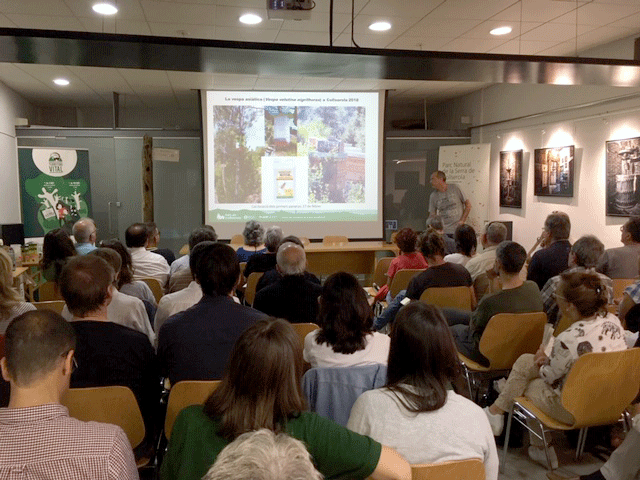
Meeting at Collserola for the Management of “Vespa velutina” – Photo by EUROPARC Federation
Chronology of an invasion
In 2017 a single individual of Asiatic hornet was detected in Collserola Nature Park. After that, the park authority quickly stablished a prompt detection and monitoring system to assess the spreading of this alien species. In September 2018, less than one year later, over 1000 Asiatic hornets have been captured in only four months in Collserola. This has rose high concerns among the local popullation, since there are several beehives scattered in the park for honey production and vineyards for wine production that have been badly affected, with half of the production ruined in the present year.
On September 27th the park authority organised a first working meeting in order to coordinate and define a common line of work with the different municipalities of the park, who in fact are the ones to deter the competence to act against this exotic species.
Measures taken at Collserola Nature Park
Jaume Cambra Sánchez, Professor at the University of Barcelona, described the biology of the species and its vital cycle which includes the construction of two nests. A primary nest in spring that is small and round shaped and that contains few workers, and a secondary one, much bigger and with horizontal stripes and a lateral hole that is built durig the summer by the workers and that can host more than 2000 individuals. He also higlighted the importance of follow only trustworthy sources of information, as there is a lot of senstaionalism and hearsay around this species after the decesase of several persons in the Iberian Peninsula since its arrival. For instances, he clarified that the Asiatic hornet, so called killer hornet, inoculates the same amount of venom than any other common wasp in this region, its venom has the same power than in other common wasps and only those persons that show high sensibility or allergies to it can suffer more serious consequences.
“The Asiatic hornet is not more dangerous than any other common hornet found in this region; it inoculates the same amount of venom and with the same power than its relatives”
Josep Maria Olmo, technician from the Catalan government, explained that in the last 2 years there has been a boom of exotic species. It is a global problem. Administration does not act on all alien species, only on those who are really invasive. Regarding the Asian hornet, beekeepers have been the first to present a claim to the Administration in order to tackle the problem. However, the Asiatic hornet is extremely difficult to eradicate. Among the measures put in place by the local administration, taking out or destroying their nests is the prefered one, but this is a partial solution that paliates its spread but does not sort the problem.
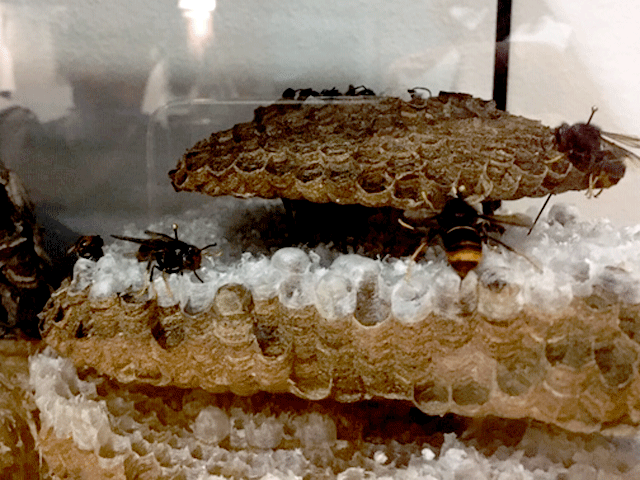
Exhibit of Asiatic hornet nest and individuals – Photo by EUROPARC Federation
Emili Bassols, technician from la Garrotxa Natural Park, stated that we will need to learn how to live together with the Asiatic hornet. He describes the process of how they have lived in his park the arrival of the Asian horne, with media causing a general alarm among the population and, a baseline of entomological ignorance shared among the inhabitants and the proliferation of housemade and uncontrolled traps, which can be more detrimental for the environment than benefitial.
“We need to learn how to coexist with the Asiatic hornet, as it has come to stay”
Marta Miralles, technician from Sant Celoni municipality, gave her experience as a representative of a local administration that has had to assume the control of the Asiatic hornet, especially with regards of health and safety towards the population. She also explained the control measures that the municipality has put in place and the responsibilities that the citizenship have to take to be able to control its expansion.
Lastly, the private company Bionet reviewed the different methodologies currently employed to remove the nests, and spoke about their experience with this species.
For further information, contact Teresa Pastor t.pastor@europarc.org
